Emulation Evaluation of Interior Beam–Column Connections in PC and RC Moment-Resisting Frames
Abstract
:1. Introduction
- ①
- Before the drift ratio of the specimen reaches the allowable drift ratio, the lateral strength (load or moment) of the specimen must be equal to or greater than the nominal lateral strength (load or moment) En.
- ②
- The maximum lateral strength, Emax, should not exceed the lateral strength (λEn) multiplied by the excess factor (λ).
- ③
- The third complete hysteresis curve at the critical drift ratio must satisfy the following conditions:
- -
- It should be 0.75 times the maximum lateral load (Emax) or greater.
- -
- The relative energy dissipation ratio must be 1/8 or greater.
- -
- The secant stiffness at 1/10 of the critical drift ratio must be 0.05 times that of the initial stiffness or greater.
- ①
- The flexural yielding strength of PC members must be equal to or greater than that of RC members.
- ②
- The strength of PC members must be equal to or greater than that of RC members.
- ③
- The strength as measured in the second complete hysteresis curve at the critical drift ratio must remain within 80%.
- ④
- The deformation at flexural yielding of PC members should not differ by more than 20% from that of RC members.
2. Test Program
2.1. Specimen and Design Parameters
2.2. Material Specifications
2.3. Test Setup, Instrumentation, and Loading Protocol
3. Test Results and Discussion
3.1. Crack Patterns and Story Shear–Drift Angle
3.2. Shear Stress-Strain
3.3. Strain Distribution
3.4. Ductility Index and Energy Dissipation Capacity
3.5. Emulation Evaluation of Specimens
4. Conclusions
- (1)
- As intended by the design, the load–drift angle relationship and crack pattern, shear stress–strain relationship, ductility index, and energy dissipation capacity of the fractured specimens showed that the PC specimens had a structural performance similar to that of RC specimens.
- (2)
- In the cases of PC-BJ2-I and PC-B-S, the seismic performance decreased compared to that of RC due to the failure of the column reinforcement in the splice sleeve, confirming the importance of the mortar filling of the splice sleeve.
- (3)
- In the I series, the relative evaluation criteria of yield strength, deformation at yield, and maximum strength showed a seismic performance more than equivalent to that of RC; the absolute evaluation criteria of stiffness was also satisfied.
- (4)
- In the S series, the relative evaluation criteria showed a seismic performance lower than that of RC, while the absolute evaluation criterion, stiffness, showed satisfactory results.
- (5)
- The emulation evaluation criteria for PC structures targeting special moment-resisting frames (strong seismic zones) confirmed the possibility of applying intermediate moment-resisting frames to target medium/weak seismic zones. However, further research is needed to examine the influence of the beam–column moment ratio.
Author Contributions
Funding
Institutional Review Board Statement
Informed Consent Statement
Data Availability Statement
Conflicts of Interest
References
- Arnell, N.W.; Lowe, J.A.; Challinor, A.J.; Osborn, T.J. Global and regional impacts of climate change at different levels of global temperature increase. Clim. Chang. 2019, 155, 377–391. [Google Scholar] [CrossRef]
- Lee, Y.J.; Kim, M.J.; Kim, D.H.; Kim, K.H. Shear Performance for Prestressed Concrete Hollow Core Slabs. Appl. Sci. 2020, 10, 1636. [Google Scholar] [CrossRef]
- Escalante-Garcia, J.I.; Sharp, J.H. Effect of temperature on the hydration of the main clinker phases in Portland cements: Part II, blended cements. Cem. Concr. Res. 1998, 28, 1259–1274. [Google Scholar] [CrossRef]
- Englekirk, R.E. Concepts for the Development of Earthquake Resistant Ductile Frames of Precast Concrete. PCI J. 1987, 32, 30–48. [Google Scholar] [CrossRef]
- Englekirk, R.E. Seismic design considerations for precast concrete multistory buildings. PCI J. 1990, 35, 40–51. [Google Scholar] [CrossRef]
- Palmieri, L.; Saqan, E.; French, C.; Kreger, M. Ductile connections for precast concrete frame systems. Spec. Publ. 1996, 162, 313–356. [Google Scholar]
- Restrepo, J.I.; Park, R.; Buchanan, A.H. Tests on connections of earthquake resisting precast reinforced concrete perimeter frames of buildings. PCI J. 1995, 40, 44–61. [Google Scholar] [CrossRef]
- Ha, S.S.; Lee, M.S.; Moon, J.H. Performance evaluation of semi precast concrete beam-column connections with U-shaped strands. Adv. Struct. Eng. 2014, 17, 1585–1600. [Google Scholar] [CrossRef]
- Gual, D.; Guo, Z.; Xiao, Q.; Zheng, Y. Experimental study of a new beam-to-column connection for precast concrete frames under reversal cyclic loading. Adv. Struct. Eng. 2016, 19, 529–545. [Google Scholar]
- Alcocer, S.M.; Carranza, R.; Perez-Navarrete, D.; Martinez, R. Seismic tests of beam-to-column connections in a precast concrete frame. PCI J. 2002, 7, 70–89. [Google Scholar] [CrossRef]
- Ochs, J.E.; Ehsani, M.R. Moment resistant connections in precast concrete frames for seismic regions. PCI J. 1993, 38, 64–75. [Google Scholar] [CrossRef]
- Soubra, K.S.; Naaman, A.E. Cyclic response of fibrous cast-in-place connections in precast beam-column sub assemblages. Struct. J. 1993, 90, 316–323. [Google Scholar]
- Breccolotti, M.; Gentile, S.; Tommasini, M.; Materazzi, A.L.; Bonfigli, M.F.; Pasqualini, B.; Colone, V.; Gianesini, M. Beam-column joints in continuous RC frames: Comparison between cast-in-situ and precast solutions. Eng. Struct. 2016, 127, 129–144. [Google Scholar] [CrossRef]
- Ghayeb, H.H.; Razak, H.A.; Ramli Sulong, N.H. Performance of dowel beam-to-column connections for precast concrete systems under seismic loads: A review. Constr. Build. Mater. 2020, 237, 117582. [Google Scholar] [CrossRef]
- Magliulo, G.; D’Angela, D.; Piccolo, V.; Di Salvatore, C.; Caterino, N. Seismic capacity and performance of code-conforming single-story RC precast buildings considering multiple limit states and damage criteria. J Build. Eng. 2023, 70, 106316. [Google Scholar] [CrossRef]
- Building Seismic Safety Concil. NEHRP Recommended Provisions for Seismic Regulations for New Buildings; FEMA: Washington, DC, USA, 1994. [Google Scholar]
- fib Task Group 6.2. Structural Connections for Precast Concrete Buildings. In Fib Bulletin 43; FIB: Lausanne, Switzerland, 2008. [Google Scholar]
- Elliott, K.S.; Jolly, C. Multi-Storey Precast Concrete Framed Structures; Wiley: Hoboken, NJ, USA, 2013. [Google Scholar]
- ASCE/SEI 7-22; Minimum Design Loads and Associated Criteria for Buildings and Other Structures. American Society of Civil Engineers: Reston, VA, USA, 2022.
- ACI T1.1-01; Acceptance Criteria for Moment Frames Based on Structural Testing and Commentary. ACI: Farmington Hills, MI, USA, 2005.
- AIJ. Guidelines for the Design of Structural Precast Concrete Emulating Cast-in-Place Reinforced Concrete; Architectural Institute of Japan: Tokyo, Japan, 2002; p. 261. [Google Scholar]
- Im, H.J.; Park, H.G.; Eom, T.S. Cyclic loading test for reinforced-concrete-emulated beam column connection of precast concrete moment frame. ACI Struct. J. 2013, 110, 115–125. [Google Scholar]
- Girgin, S.C.; Misir, I.S.; Kahraman, S. Experimental cyclic behavior of precast hybrid beam-column connections with welded components. Int. J. Concr. Struct. Mater. 2017, 11, 229–245. [Google Scholar] [CrossRef]
- Lee, J.Y.; Kim, J.Y.; Oh, G.J. Strength deterioration of reinforced concrete beam-column joints subjected to cyclic loading. Eng. Struct. 2009, 31, 2070–2085. [Google Scholar] [CrossRef]
- ACI 318-19; Building Code Requirements for Structural Concrete (ACI 318-19) and Commentary (ACI 318R-19). American Concrete Institute: Detroit, MI, USA, 2019.
- Joint ACI-ASCE Committee 352. Recommendations for Design of Beam-Column Connections in Monolithic Reinforced Concrete Structures (ACI 352R-02); American Concrete Institute: Farmington Hills, MI, USA, 2002. [Google Scholar]
- Paulay, T.; Priestley, M.N. Seismic Design of Reinforced Concrete and Masonry Buildings; Wiley: New York, NY, USA, 1992. [Google Scholar]
- Yang, H.; Zhao, W.; Zhu, Z.; Fu, J. Seismic behavior comparison of reinforced concrete interior beam-column joints based on different loading methods. Eng. Struct. 2018, 166, 31–45. [Google Scholar] [CrossRef]
- Masi, A.; Santarsiero, G. Seismic Tests on RC Building Exterior Joints with Wide Beams. Adv. Mater. Res. 2013, 787, 771–777. [Google Scholar] [CrossRef]
- Benavent-Climent, A.; Cahís, X.; Vico, J.M. Interior wide beam-column connections in existing RC frames subjected to lateral earthquake loading. Bull. Earthq. Eng. 2010, 8, 401–420. [Google Scholar] [CrossRef]
- Lee, J.-Y.; Haroon, M.; Park, J. Deformability of Reinforced Concrete Beam-Column Joints Considering Strain Penetration Effect. ACI Struct. J. 2022, 119, 51–68. [Google Scholar]
- Beckingsale, C.W. Post Elastic Behavior of Reinforced Concrete Beam-Column Joints. Ph.D. Thesis, University of Canterbury, Christchurch, New Zealand, 1980. [Google Scholar]
- Chang, B.; Hutchinson, T.; Wang, X.; Englekirk, R. Seismic performance of beam-column subassemblies with high strength steel reinforcement. ACI Struct. J. 2017, 145, 305–321. [Google Scholar] [CrossRef]
- Lee, J.Y.; Heo, J.H.; Byun, H.W.; Kim, K.H.; Shin, D.I. Comparison of emulation evaluation methods of precast concrete moment resistance structures. Eng. Struct. 2023, 291, 116416. [Google Scholar] [CrossRef]
- American Institute of Steel Construction. Seismic Provisions for Structural Steel Buildings; American Institute of Steel Construction: Chicago, IL, USA, 2016; p. 429. [Google Scholar]

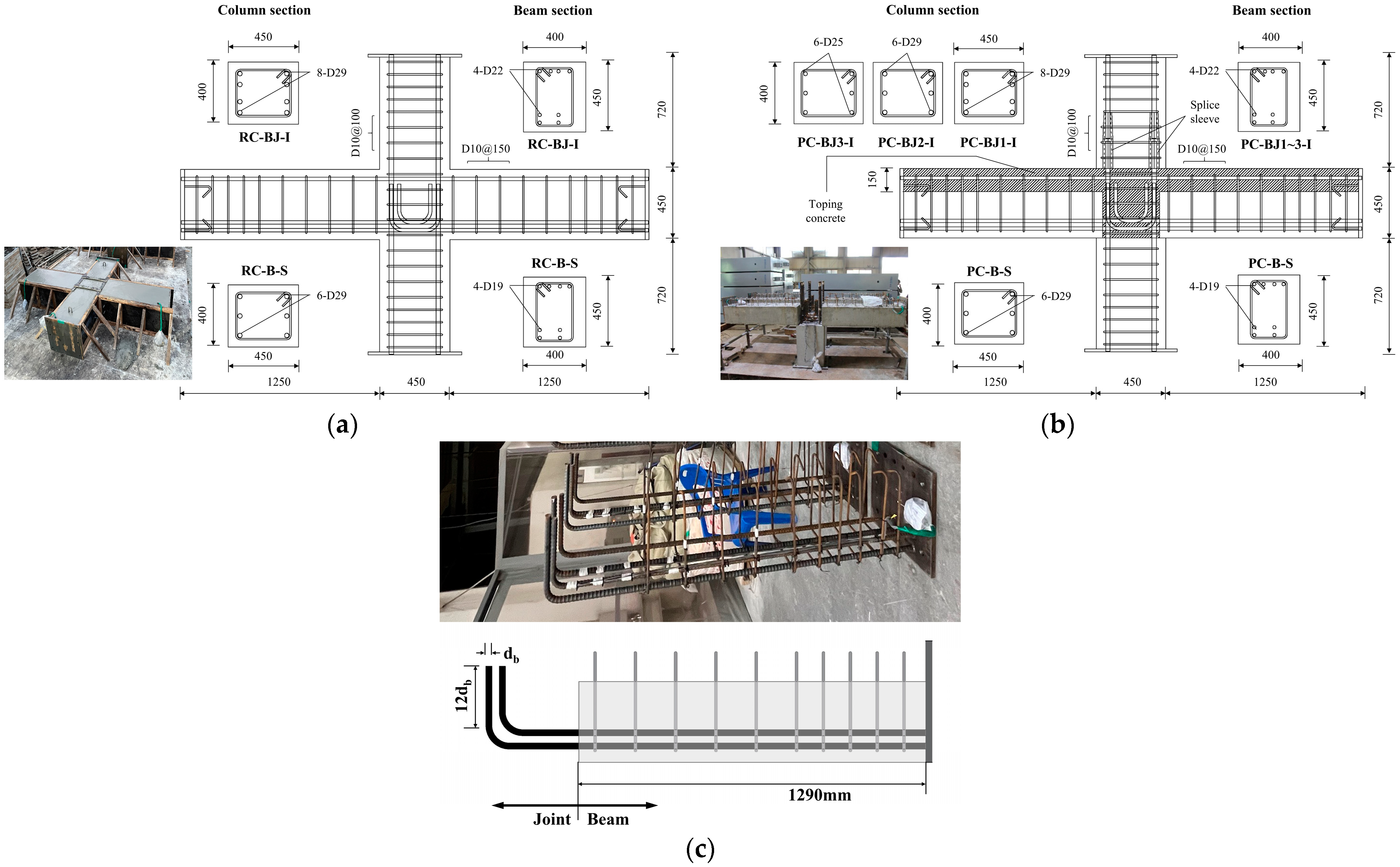
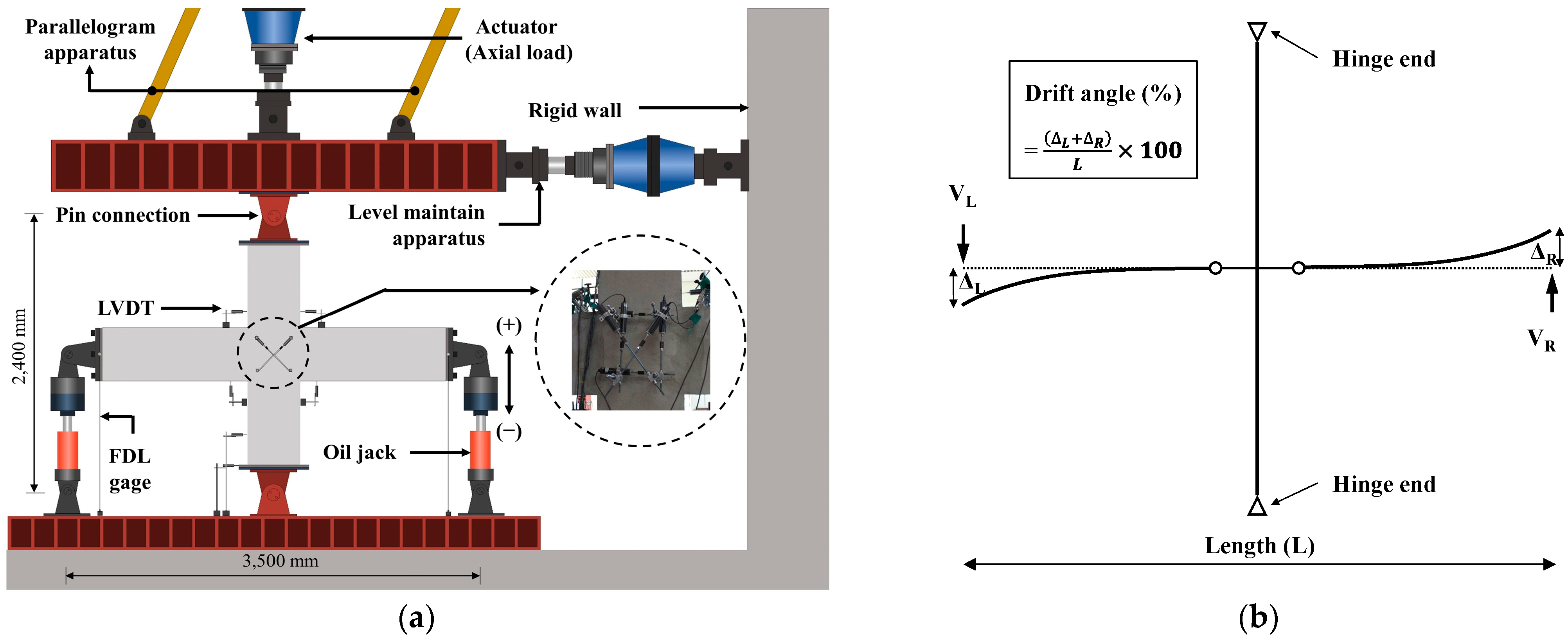
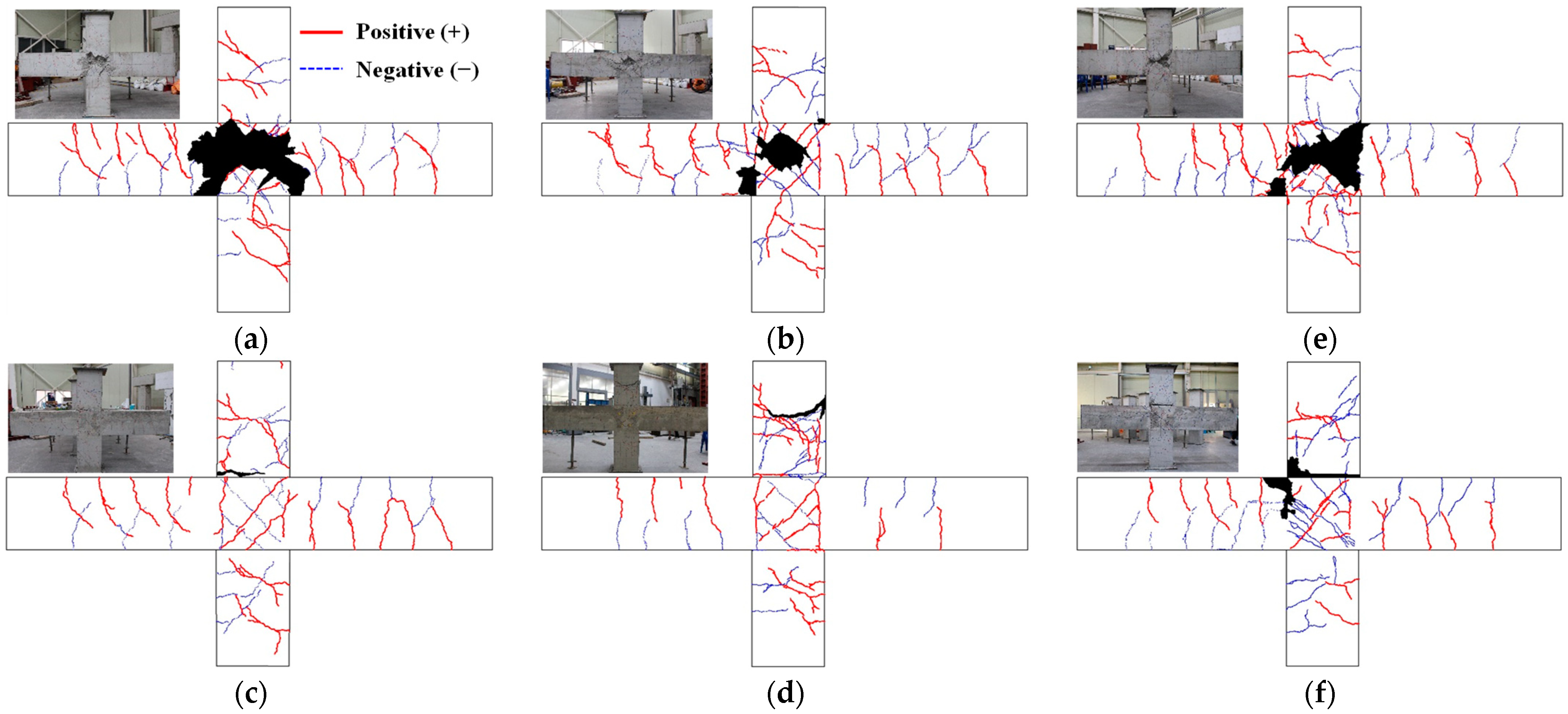



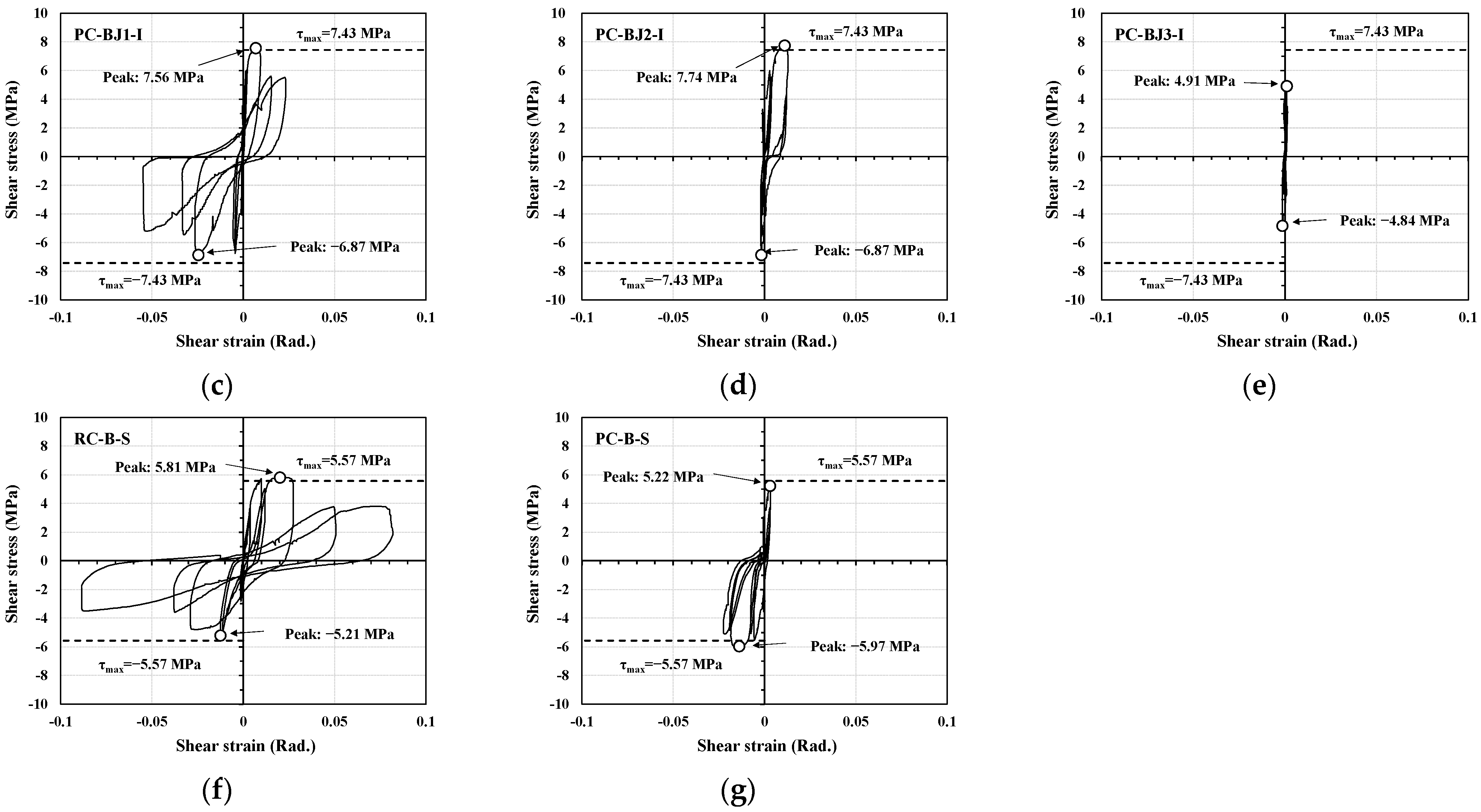
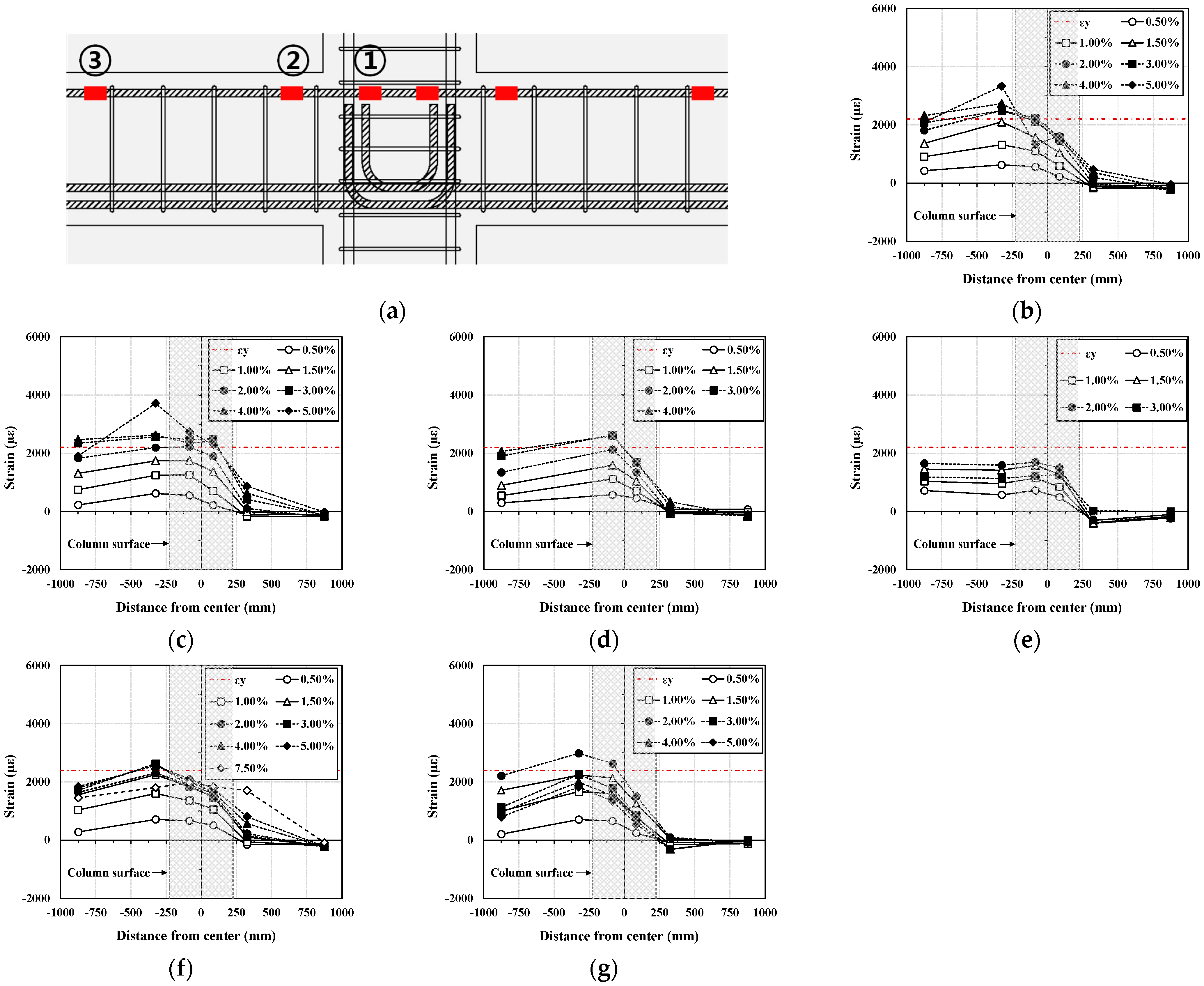
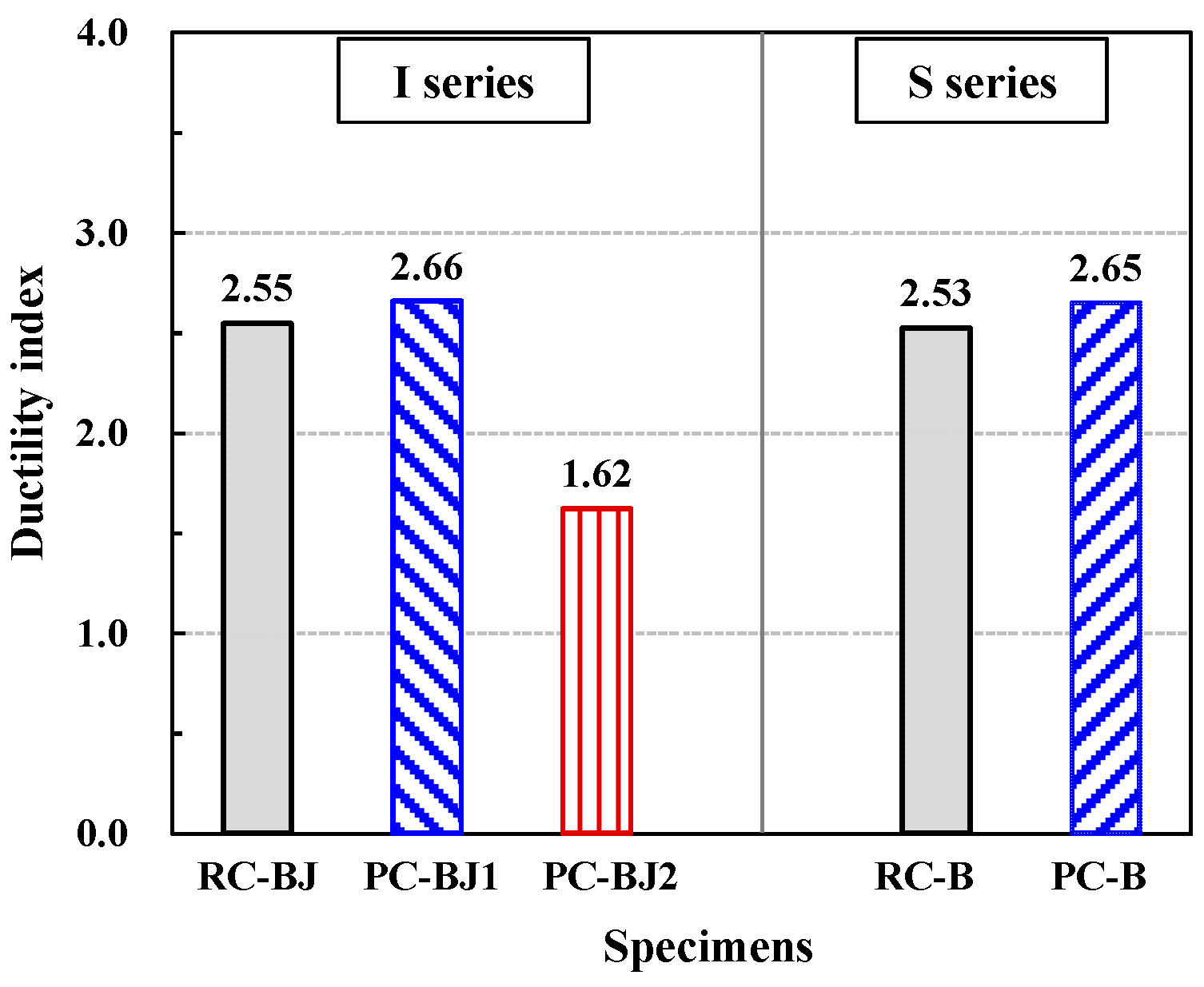

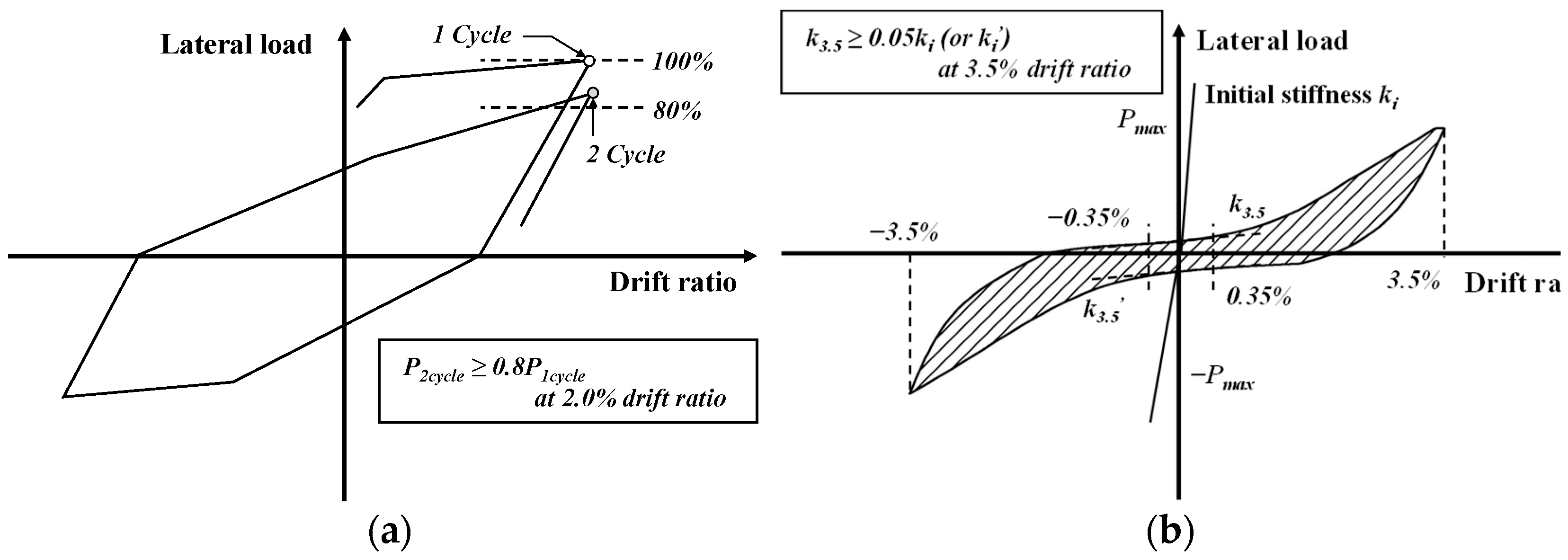
| Specimens | Beam Joint Capacity Ratio | Beam–Column Capacity Ratio | |||||
|---|---|---|---|---|---|---|---|
| Vj1/Vjby | Vj1 (kN) | Vjby (kN) | Mc/Mb | Mc (kN·m) | Mb (kN·m) | ||
| I series | RC-BJ-I | 1.25 | 1669.5 | 1337.9 | 1.65 | 427.7 | 259.4 |
| PC-BJ1-I | 1.25 | 1669.5 | 1337.9 | 1.65 | 427.7 | 259.4 | |
| PC-BJ2-I | 1.25 | 1669.5 | 1337.9 | 1.24 | 320.8 | 259.4 | |
| PC-BJ3-I | 1.25 | 1669.5 | 1337.9 | 0.98 | 253.2 | 259.4 | |
| S series | RC-B-S | 1.66 | 1669.5 | 1002.9 | 1.63 | 320.8 | 196.6 |
| PC-B-S | 1.66 | 1669.5 | 1002.9 | 1.63 | 320.8 | 196.6 | |
| Moment-Resisting Frame | Specimen | fck (MPa) | Column | Beam | ||||||
|---|---|---|---|---|---|---|---|---|---|---|
| Rebar | Hoop | Rebar | Stirrup | |||||||
| fcy (MPa) | nc | fh (MPa) | nh | fby (MPa) | nb | fs (MPa) | ns | |||
| I series | RC-BJ-I | 35 | 439 | 8-D29 | 558 | D10 @100 | 479 | 4-D22 | 558 | D10 @150 |
| PC-BJ1-I | 35 | 439 | 8-D29 | 558 | D10 @100 | 479 | 4-D22 | 558 | D10 @150 | |
| PC-BJ2-I | 35 | 439 | 6-D29 | 558 | D10 @100 | 479 | 4-D22 | 558 | D10 @150 | |
| PC-BJ3-I | 35 | 442 | 6-D25 | 558 | D10 @100 | 479 | 4-D22 | 558 | D10 @150 | |
| S series | RC-B-S | 35 | 439 | 6-D29 | 558 | D10 @100 | 448 | 4-D19 | 558 | D10 @150 |
| PC-B-S | 35 | 439 | 6-D29 | 558 | D10 @100 | 448 | 4-D19 | 558 | D10 @150 | |
| Rebar | fy* (MPa) | εy (mm/mm) | Es (GPa) | Type of Specimens | |
|---|---|---|---|---|---|
| Column longitudinal | D29 | 439 | 0.002384 | 189 | RC-BJ-I, PC-BJ1-I, PC-BJ2-I, RC-B-S, PC-B-S |
| D25 | 442 | 0.002384 | 185 | PC-BJ3-I | |
| Beam longitudinal | D22 | 480 | 0.002571 | 186 | RC-BJ-I, PC-BJ1-I, PC-BJ2-I, PC-BJ3-I |
| D19 | 448 | 0.002523 | 177 | RC-B-S, PC-B-S | |
| Transverse | D10 | 559 | 0.003023 | 185 | All specimens |
| Specimen | Py (kN) | θy (%) | Δy (mm) | Ppeak (kN) | θpeak (%) | Δpeak (mm) | θ0.8peak (mm) | Δ0.8peak (mm) | Ductility Index | |
|---|---|---|---|---|---|---|---|---|---|---|
| I series | RC-BJ-I | 147.1 | 1.94 | 34.0 | 167.9 −147.9 | 3.44 −2.22 | 60.2 −38.9 | 4.90 −5.00 | 85.7 −87.6 | 2.55 |
| PC-BJ1-I | −145.8 | −1.96 | −34.0 | 173.5 −157.8 | 3.48 −4.02 | 60.9 −70.4 | 4.90 −5.43 | 85.8 −95.0 | 2.66 | |
| PC-BJ2-I | 132.2 | 2.20 | 38.5 | 177.6 −157.7 | 4.15 −2.18 | 72.6 −38.2 | 4.34 −2.79 | 76.0 −48.8 | 1.62 | |
| PC-BJ3-I | - | - | - | 112.7 −111.1 | 2.00 −1.80 | 35.0 −31.5 | 2.34 −2.92 | 40.9 −51.1 | - | |
| S series | RC-B-S | 131.2 | 2.56 | 44.8 | 133.3 −119.7 | 4.36 −2.56 | 76.3 −44.8 | 6.07 −6.86 | 106.2 −120.0 | 2.53 |
| PC-B-S | 101.6 | 1.78 | 31.2 | 119.9 −137.0 | 2.56 −4.48 | 44.8 −78.4 | 2.97 −6.48 | 52.0 −113.3 | 2.65 | |
| Specimen | RC-BJ-I | PC-BJ1-I | RC-B-S | PC-B-S | |||||
|---|---|---|---|---|---|---|---|---|---|
| Loading Direction | (+) | (−) | (+) | (−) | (+) | (−) | (+) | (−) | |
| Strength reduction, (kN) * (AIJ [21]) | P2.0, 1 cycle | 149.9 | 136.2 | 125.2 | 112.2 | ||||
| 0.8P2.0, 1 cycle | 119.9 | 109.0 | 100.2 | 89.8 | |||||
| P2.0, 2 cycle | 135.1 | 135.6 | 89.8 | 74.2 | |||||
| Stiffness, (kN/mm) ** (ACI 374.1-05 [20]) | ki | 4.34 | 4.21 | 3.96 | 4.24 | 2.93 | 2.67 | 3.26 | 3.65 |
| 0.05ki | 0.22 | 0.21 | 0.20 | 0.21 | 0.15 | 0.13 | 0.16 | 0.18 | |
| K3.5 | 1.78 | 1.41 | 1.80 | 1.64 | 1.04 | 0.84 | 1.07 | 2.13 | |
Disclaimer/Publisher’s Note: The statements, opinions and data contained in all publications are solely those of the individual author(s) and contributor(s) and not of MDPI and/or the editor(s). MDPI and/or the editor(s) disclaim responsibility for any injury to people or property resulting from any ideas, methods, instructions or products referred to in the content. |
© 2023 by the authors. Licensee MDPI, Basel, Switzerland. This article is an open access article distributed under the terms and conditions of the Creative Commons Attribution (CC BY) license (https://creativecommons.org/licenses/by/4.0/).
Share and Cite
Jo, M.-S.; Kim, H.-G.; Kim, D.-H.; Lee, Y.-J.; Han, S.-P.; Kim, K.-H. Emulation Evaluation of Interior Beam–Column Connections in PC and RC Moment-Resisting Frames. Materials 2023, 16, 6906. https://doi.org/10.3390/ma16216906
Jo M-S, Kim H-G, Kim D-H, Lee Y-J, Han S-P, Kim K-H. Emulation Evaluation of Interior Beam–Column Connections in PC and RC Moment-Resisting Frames. Materials. 2023; 16(21):6906. https://doi.org/10.3390/ma16216906
Chicago/Turabian StyleJo, Min-Su, Hyeong-Gook Kim, Dong-Hwan Kim, Yong-Jun Lee, Sang-Pil Han, and Kil-Hee Kim. 2023. "Emulation Evaluation of Interior Beam–Column Connections in PC and RC Moment-Resisting Frames" Materials 16, no. 21: 6906. https://doi.org/10.3390/ma16216906
APA StyleJo, M.-S., Kim, H.-G., Kim, D.-H., Lee, Y.-J., Han, S.-P., & Kim, K.-H. (2023). Emulation Evaluation of Interior Beam–Column Connections in PC and RC Moment-Resisting Frames. Materials, 16(21), 6906. https://doi.org/10.3390/ma16216906






